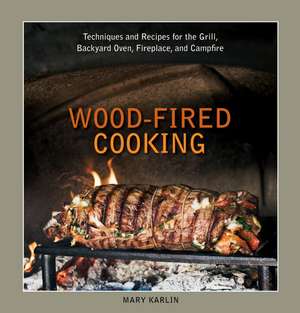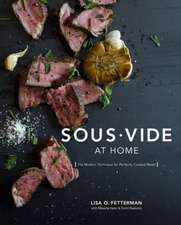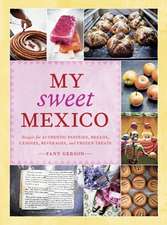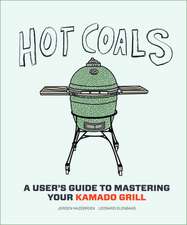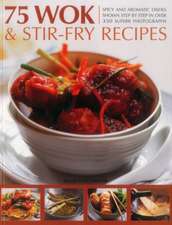Wood-Fired Cooking: Techniques and Recipes for the Grill, Backyard Oven, Fireplace, and Campfire
Autor Mary Karlin Fotografii de Ed Andersonen Limba Engleză Hardback – 31 ian 2009
Her globally inspired Indian, Italian, Mediterranean, American, and North African recipes for cooking over live flame and embers are paired with contributions from Peter Reinhart, Bruce Aidells, Deborah Madison, and other fired-up chefs. Whether you're a seasoned barbecue expert or you just bought your first bag of lump charcoal, WOOD-FIRED COOKING will have you stoking appetites in no time.
Preț: 130.17 lei
Preț vechi: 150.50 lei
-14% Nou
Puncte Express: 195
Preț estimativ în valută:
24.91€ • 27.05$ • 20.93£
24.91€ • 27.05$ • 20.93£
Carte disponibilă
Livrare economică 01-08 aprilie
Livrare express 15-21 martie pentru 66.92 lei
Preluare comenzi: 021 569.72.76
Specificații
ISBN-13: 9781580089456
ISBN-10: 1580089453
Pagini: 200
Ilustrații: 50 full-colour photographs
Dimensiuni: 217 x 232 x 21 mm
Greutate: 0.89 kg
Editura: Ten Speed Press
Locul publicării:United States
ISBN-10: 1580089453
Pagini: 200
Ilustrații: 50 full-colour photographs
Dimensiuni: 217 x 232 x 21 mm
Greutate: 0.89 kg
Editura: Ten Speed Press
Locul publicării:United States
Notă biografică
MARY KARLIN is a founding staff manager and chef-instructor at Ramekins Sonoma Valley Culinary School, where she has taught wood-fired cooking classes for nine years. Mary has also taught at Draeger's, Rancho La Puerta, and the Culinary Institute of America, Greystone. A freelance food writer and traveling instructor, Mary splits her time between northern California and Superior, Arizona, where she directs her Live-Fire Cooking Camp Culinary Center. She also teaches regional cooking camps around the United States.
THE AUTHOR SCOOP
What's your most essential kitchen tool?
Tongs
What was your inspiration for writing Wood-Fired Cooking?
My wood-burning oven; the food and community created by it. The oven made me a better cook.
If you had to boil the message of Wood-Fired Cooking down to one sentence, what would it be?
Stay connected to your food. Cook ethically, share food with others and create community wherever you can.
What food could you not live without?
Potatoes
What was your first job?
Right out of clothing design school, I was the assistant to a clothing designer in San Francisco. She was the co-owner and wife of an A-1 screamer. The place had all the fantasy images and sounds of what I thought was the typical garment manufacturer's life. It was a pressure cooker and in the first 6 months I developed an ulcer and quit. I thought that was the end of my life in the garment business. Thankfully, I was wrong and went on to other joyful positions at great companies, spending over 25 years of my life in that world. Next career, food.
THE AUTHOR SCOOP
What's your most essential kitchen tool?
Tongs
What was your inspiration for writing Wood-Fired Cooking?
My wood-burning oven; the food and community created by it. The oven made me a better cook.
If you had to boil the message of Wood-Fired Cooking down to one sentence, what would it be?
Stay connected to your food. Cook ethically, share food with others and create community wherever you can.
What food could you not live without?
Potatoes
What was your first job?
Right out of clothing design school, I was the assistant to a clothing designer in San Francisco. She was the co-owner and wife of an A-1 screamer. The place had all the fantasy images and sounds of what I thought was the typical garment manufacturer's life. It was a pressure cooker and in the first 6 months I developed an ulcer and quit. I thought that was the end of my life in the garment business. Thankfully, I was wrong and went on to other joyful positions at great companies, spending over 25 years of my life in that world. Next career, food.
Extras
Introduction
Welcome to the amazing world of wood-fired cooking. Whether you are new to this form of cooking, just curious, or are already a devotee stoking fires regularly for the pleasure of family and friends, this book was created for you.
Wood-Fired Cooking will take you on a comprehensive journey of wood-fired cooking in all its contemporary forms. It includes more than one hundred flavor-packed recipes, plus fireside stories and cooking tips. Some of the best-known authors and cooks on wood-fired cooking have joined me to cook and create some recipes for this book.
Wood-fired cooking, the foundation of a wide variety of cuisines from all over the world, includes a variety of techniques, from grilling, baking, and roasting to braising, barbecuing, and smoking. Barbecue, kebab, satay, pizza, tandoori, rotisserie are all words describing traditional wood-fired foods and techniques that have become part of our contemporary cuisine. The wide variety of wood-fired cooking methods makes the creation of delicious globally inspired food easy and fun.
While it's wonderful to have your own backyard oven or ceramic cooker, you don't really need a special cooking appliance to use this book. Most wood-fired dishes, with the exception of loaf breads, can be cooked on a wood-fired grill (flatbreads, however, are easily cooked on a grill), or in a conventional oven--though you will lose out on the smoky flavor that wood-fired cooking imparts.
All of the recipes in this book are drawn from cuisines that have brought wood-fired cooking to a high art. Many of them are steeped with the spirit of the Mediterranean--the tastes, aromas, and colors of the region, its lifestyle, and its food. Cuisines from other lands of the sun, especially Morocco and India, are also found here, transformed, like the others, by the California emphasis on freshness and innovation.
Each of the most popular wood-fired methods is thoroughly covered in this book: grilling, baking, and roasting, smoking, barbecuing, fire-pit and campfire cooking. As the popularity of live-fire cooking continues to grow throughout America, more and more wood-fired cookers, appliances, and devices have become available. This book tells you how to use all of them.
After a brief chapter on the history of wood-fired cooking, the basics of cooking with wood are discussed--everything you need to know to prepare the more than one hundred recipes that have been specifically developed to form the heart of this book. You'll learn how to prepare wonderfully flavored rustic foods for your family and friends in a tradition that goes back to the beginning of cooking with fire.
Now, let's start our fiery adventure!
Chapter 1 Cooking with Fire
Cooking with fire was one of the first steps humans took on the road toward civilization. Lightning fires and erupting volcanoes were man's first experiences with fire, and the accidental burning of animal carcasses undoubtedly introduced cooked meat to humans for the first time. But eventually fire was tamed enough to be used for open-fire and pit cooking, the oldest methods of cooking with fire.
Open-Fire Cooking: The First Grills
On the plains, in mountain caves, and around the campfire--whether on a spit or a metal grid suspended on a circle of rocks--open-fire cooking is a tradition that crosses all cultural and ethnic boundaries and is deeply infused in current culture.
Anthropologists tell us that man has been cooking over open fires since the Stone Age, making it the oldest and most widespread form of cooking. Developed by nomadic hunter-gatherers, open-fire cooking preceded contained-heat cooking in wood-fired ovens because it required only suspending part of an animal carcass over an open fire or burying it in live coals.
Eventually, techniques of cooking in animal skins, then pottery, allowed humans to boil and bake foods suspended over an open fire. But the discovery of metallurgy advanced open-fire cooking exponentially with the development of bronze cooking vessels and implements, including spears that did double duty as spits and skewers.
The first grill grates were no doubt simply green saplings crossed over a fire at right angles. When the Spanish landed in the Caribbean, they discovered the native population cooking food over an open fire on a grate woven of green sticks; the Indian word for this grate entered the Spanish language as barbacoa. Native Americans also attached fish to slabs of wood propped up at the edge of an open fire, a technique now known as planking.
The development of the home fireplace brought open-fire cooking indoors, where food was suspended over the fire on spits or in metal pots hung from hooks. Food was also cooked directly in the coals or at the edge of the fire, or on metal grates with legs set in the coals. Today, the Tuscan grill, a wrought-iron implement that fits into a fireplace opening, allows wood-fire enthusiasts to grill in their own living room throughout the year.
In this country, the barbacoa evolved over the years into the barbecue grill, becoming popular in the 1920s, when Henry Ford produced the first charcoal briquettes from scrap wood left over from making Model T's. Until the 1940s, grilling in America mostly took place at campsites or picnics. As the middle class began moving from the cities to the suburbs after World War II, backyard grilling took hold, becoming all the rage by the 1950s. Grilling's newfound popularity was due in great part to the invention of the Weber kettle grill in 1951 by George Stephen, a metal worker at Weber Brothers Metal Spinning Company, a company best known as a maker of harbor buoys. Stephen was frustrated with the flat, open grills that were popular at the time and was supposedly inspired to cut a harbor buoy in half, adding a grate and using the top as a lid. He added some vents for controlling the temperature, and the Weber kettle grill was born. Backyard grilling has never been the same. The Weber kettle grill is still popular and has spawned numerous new versions. Variations on it range from halved steel drums for huge cookouts, to disk-shaped fire pits, to massive mesquite-fired grills the size of a restaurant stove.
Underground Earthen Pits: The First Ovens
Fire pits were the first ovens: Cavities dug into the ground were lined with rocks, and a fire was built in the pit to heat the rocks. Once the coals burned down and the rocks were hot, the food was placed inside and covered during cooking. Fire pits are still popular today, especially in the tropics where the ground can be dug year-round.
Food cooked in pits is typically wrapped in plant leaves such as banana or maguey if the portions of food are small; if a whole animal carcass is being cooked a layer of vegetation is placed over the carcass for both protection and flavor. The covered food is then topped with a layer of dirt, then rocks to keep the cavity secure. This subterranean steam- and smoke-fed "oven" allows long, slow cooking with succulent results, thanks to the moist environment. Pit cooking remains popular around the world. In this country, its best-known version is the clambake, a legacy of the Native Americans, but the dug out campfires of the American West's cowboys and vaqueros also descended from fire pits. Today's box roasters are based on the principles of fire-pit cooking, and produce consistently succulent roasted foods.
Chamber Ovens: Vertical, Dome, and Egg-Shaped
Wood-fired chamber ovens have either rounded or squared compartments for cooking and are of two basic shapes: either vertical, like the tandoor oven, or horizontal, like the dome-shaped oven, sometimes called a Roman oven due to its existence dating back to the days of Pompeii. In both cases, the heat required for baking or roasting has been generated and stored in the structural mass of the vessel before cooking takes place. Sometimes a small fire is kept burning in the oven to maintain even heat. A door (or lid, in the case of a tandoor) is placed into the oven opening during cooking to keep the generated heat and smoke in the chamber.
The first wood-fired chamber ovens were probably built thousands of years ago in Egypt. We know that the peoples of the southern and eastern Mediterranean cultivated grain and ground it into flour to make simple unleavened flatbreads, which were cooked on a flat stone surrounded and fueled by smaller fire-heated stones. As leavened breads were developed, the first chamber ovens were crafted: vertical ovens molded from clay to yield the kind of sustained, even heat needed to bake yeasted doughs. Traditionally made of local clay, vertical ovens have their heat source in their base, and versions of them are found in native cultures around the world. The best known to Westerners is the Indian tandoor, which uses a coal or wood fire. Flatbread dough is slapped onto the walls of the heated cylinder to quickly bake, and seasoned meats and vegetables are suspended on metal skewers and placed in the heated cavity, where they cook from the radiant heat of the masonry walls and the small fire at the base. These ovens were traditionally buried in the ground, and the cook would sit on the ground to cook the food.
Today's egg-shaped ovens are directly descended from the vertical clay oven. One of the best known is the kamado. Developed over three thousand years ago in China, this charcoal-fired clay cooker was adopted by the Japanese, who gave it its name, which means "oven" or "fireplace." These cookers have an egg-shaped, insulated ceramic body with a grill grate that is near the top of the body, making them a combination of grill and oven: When the lid is off, they function just as a grill; with the lid on, they retain heat comparable to an oven. And, when heated to low temperatures, they are also effective smokers. After World War II, thousands of American soldiers brought these cookers home to the United States just as the grilling craze was on the rise. Today's versions of these cookers have evolved in styling and efficiency and are extremely versatile.
Early European dome ovens were large versions of the horizontal Roman oven and made of regional clay and stones. They were built to bake large quantities of bread and were located in the center of the village, where they functioned as a communal oven and a gathering place. Most villages had large dome ovens that were managed by the village bakers. Once the daily bread had been baked, the villagers were allowed to use the still-hot ovens to cook dishes of food for themselves. These communal ovens stayed in use in Europe until after World War II, when home ovens began to become available.
The wood-fired pizza oven in a variety of shapes is one modern version of the dome oven, which has become newly popular today. Some homeowners build their own traditional clay or masonry ovens, while several companies offer plans for permanent bread ovens, and others sell portable versions.
Welcome to the amazing world of wood-fired cooking. Whether you are new to this form of cooking, just curious, or are already a devotee stoking fires regularly for the pleasure of family and friends, this book was created for you.
Wood-Fired Cooking will take you on a comprehensive journey of wood-fired cooking in all its contemporary forms. It includes more than one hundred flavor-packed recipes, plus fireside stories and cooking tips. Some of the best-known authors and cooks on wood-fired cooking have joined me to cook and create some recipes for this book.
Wood-fired cooking, the foundation of a wide variety of cuisines from all over the world, includes a variety of techniques, from grilling, baking, and roasting to braising, barbecuing, and smoking. Barbecue, kebab, satay, pizza, tandoori, rotisserie are all words describing traditional wood-fired foods and techniques that have become part of our contemporary cuisine. The wide variety of wood-fired cooking methods makes the creation of delicious globally inspired food easy and fun.
While it's wonderful to have your own backyard oven or ceramic cooker, you don't really need a special cooking appliance to use this book. Most wood-fired dishes, with the exception of loaf breads, can be cooked on a wood-fired grill (flatbreads, however, are easily cooked on a grill), or in a conventional oven--though you will lose out on the smoky flavor that wood-fired cooking imparts.
All of the recipes in this book are drawn from cuisines that have brought wood-fired cooking to a high art. Many of them are steeped with the spirit of the Mediterranean--the tastes, aromas, and colors of the region, its lifestyle, and its food. Cuisines from other lands of the sun, especially Morocco and India, are also found here, transformed, like the others, by the California emphasis on freshness and innovation.
Each of the most popular wood-fired methods is thoroughly covered in this book: grilling, baking, and roasting, smoking, barbecuing, fire-pit and campfire cooking. As the popularity of live-fire cooking continues to grow throughout America, more and more wood-fired cookers, appliances, and devices have become available. This book tells you how to use all of them.
After a brief chapter on the history of wood-fired cooking, the basics of cooking with wood are discussed--everything you need to know to prepare the more than one hundred recipes that have been specifically developed to form the heart of this book. You'll learn how to prepare wonderfully flavored rustic foods for your family and friends in a tradition that goes back to the beginning of cooking with fire.
Now, let's start our fiery adventure!
Chapter 1 Cooking with Fire
Cooking with fire was one of the first steps humans took on the road toward civilization. Lightning fires and erupting volcanoes were man's first experiences with fire, and the accidental burning of animal carcasses undoubtedly introduced cooked meat to humans for the first time. But eventually fire was tamed enough to be used for open-fire and pit cooking, the oldest methods of cooking with fire.
Open-Fire Cooking: The First Grills
On the plains, in mountain caves, and around the campfire--whether on a spit or a metal grid suspended on a circle of rocks--open-fire cooking is a tradition that crosses all cultural and ethnic boundaries and is deeply infused in current culture.
Anthropologists tell us that man has been cooking over open fires since the Stone Age, making it the oldest and most widespread form of cooking. Developed by nomadic hunter-gatherers, open-fire cooking preceded contained-heat cooking in wood-fired ovens because it required only suspending part of an animal carcass over an open fire or burying it in live coals.
Eventually, techniques of cooking in animal skins, then pottery, allowed humans to boil and bake foods suspended over an open fire. But the discovery of metallurgy advanced open-fire cooking exponentially with the development of bronze cooking vessels and implements, including spears that did double duty as spits and skewers.
The first grill grates were no doubt simply green saplings crossed over a fire at right angles. When the Spanish landed in the Caribbean, they discovered the native population cooking food over an open fire on a grate woven of green sticks; the Indian word for this grate entered the Spanish language as barbacoa. Native Americans also attached fish to slabs of wood propped up at the edge of an open fire, a technique now known as planking.
The development of the home fireplace brought open-fire cooking indoors, where food was suspended over the fire on spits or in metal pots hung from hooks. Food was also cooked directly in the coals or at the edge of the fire, or on metal grates with legs set in the coals. Today, the Tuscan grill, a wrought-iron implement that fits into a fireplace opening, allows wood-fire enthusiasts to grill in their own living room throughout the year.
In this country, the barbacoa evolved over the years into the barbecue grill, becoming popular in the 1920s, when Henry Ford produced the first charcoal briquettes from scrap wood left over from making Model T's. Until the 1940s, grilling in America mostly took place at campsites or picnics. As the middle class began moving from the cities to the suburbs after World War II, backyard grilling took hold, becoming all the rage by the 1950s. Grilling's newfound popularity was due in great part to the invention of the Weber kettle grill in 1951 by George Stephen, a metal worker at Weber Brothers Metal Spinning Company, a company best known as a maker of harbor buoys. Stephen was frustrated with the flat, open grills that were popular at the time and was supposedly inspired to cut a harbor buoy in half, adding a grate and using the top as a lid. He added some vents for controlling the temperature, and the Weber kettle grill was born. Backyard grilling has never been the same. The Weber kettle grill is still popular and has spawned numerous new versions. Variations on it range from halved steel drums for huge cookouts, to disk-shaped fire pits, to massive mesquite-fired grills the size of a restaurant stove.
Underground Earthen Pits: The First Ovens
Fire pits were the first ovens: Cavities dug into the ground were lined with rocks, and a fire was built in the pit to heat the rocks. Once the coals burned down and the rocks were hot, the food was placed inside and covered during cooking. Fire pits are still popular today, especially in the tropics where the ground can be dug year-round.
Food cooked in pits is typically wrapped in plant leaves such as banana or maguey if the portions of food are small; if a whole animal carcass is being cooked a layer of vegetation is placed over the carcass for both protection and flavor. The covered food is then topped with a layer of dirt, then rocks to keep the cavity secure. This subterranean steam- and smoke-fed "oven" allows long, slow cooking with succulent results, thanks to the moist environment. Pit cooking remains popular around the world. In this country, its best-known version is the clambake, a legacy of the Native Americans, but the dug out campfires of the American West's cowboys and vaqueros also descended from fire pits. Today's box roasters are based on the principles of fire-pit cooking, and produce consistently succulent roasted foods.
Chamber Ovens: Vertical, Dome, and Egg-Shaped
Wood-fired chamber ovens have either rounded or squared compartments for cooking and are of two basic shapes: either vertical, like the tandoor oven, or horizontal, like the dome-shaped oven, sometimes called a Roman oven due to its existence dating back to the days of Pompeii. In both cases, the heat required for baking or roasting has been generated and stored in the structural mass of the vessel before cooking takes place. Sometimes a small fire is kept burning in the oven to maintain even heat. A door (or lid, in the case of a tandoor) is placed into the oven opening during cooking to keep the generated heat and smoke in the chamber.
The first wood-fired chamber ovens were probably built thousands of years ago in Egypt. We know that the peoples of the southern and eastern Mediterranean cultivated grain and ground it into flour to make simple unleavened flatbreads, which were cooked on a flat stone surrounded and fueled by smaller fire-heated stones. As leavened breads were developed, the first chamber ovens were crafted: vertical ovens molded from clay to yield the kind of sustained, even heat needed to bake yeasted doughs. Traditionally made of local clay, vertical ovens have their heat source in their base, and versions of them are found in native cultures around the world. The best known to Westerners is the Indian tandoor, which uses a coal or wood fire. Flatbread dough is slapped onto the walls of the heated cylinder to quickly bake, and seasoned meats and vegetables are suspended on metal skewers and placed in the heated cavity, where they cook from the radiant heat of the masonry walls and the small fire at the base. These ovens were traditionally buried in the ground, and the cook would sit on the ground to cook the food.
Today's egg-shaped ovens are directly descended from the vertical clay oven. One of the best known is the kamado. Developed over three thousand years ago in China, this charcoal-fired clay cooker was adopted by the Japanese, who gave it its name, which means "oven" or "fireplace." These cookers have an egg-shaped, insulated ceramic body with a grill grate that is near the top of the body, making them a combination of grill and oven: When the lid is off, they function just as a grill; with the lid on, they retain heat comparable to an oven. And, when heated to low temperatures, they are also effective smokers. After World War II, thousands of American soldiers brought these cookers home to the United States just as the grilling craze was on the rise. Today's versions of these cookers have evolved in styling and efficiency and are extremely versatile.
Early European dome ovens were large versions of the horizontal Roman oven and made of regional clay and stones. They were built to bake large quantities of bread and were located in the center of the village, where they functioned as a communal oven and a gathering place. Most villages had large dome ovens that were managed by the village bakers. Once the daily bread had been baked, the villagers were allowed to use the still-hot ovens to cook dishes of food for themselves. These communal ovens stayed in use in Europe until after World War II, when home ovens began to become available.
The wood-fired pizza oven in a variety of shapes is one modern version of the dome oven, which has become newly popular today. Some homeowners build their own traditional clay or masonry ovens, while several companies offer plans for permanent bread ovens, and others sell portable versions.
Recenzii
"A wood fire is always the heart and hearth of a social gathering--I never feel more at home than when I'm cooking over the flames. Mary Karlin's comprehensive and beautiful book introduces you to one of our most ancient, basic, and satisfying ways to cook." --Alice Waters, founder and co-owner of Chez Panisse and author of The Art of Simple Food
"In Wood-Fired Cooking, Mary Karlin combines the romance of the fire with practical information and really delicious recipes that are easy to prepare. A surefire hit." --Joyce Goldstein, chef and author of Back to Square One and Italian Slow and Savory
"Wood-Fired Cooking is sure to inspire and inform the growing leagues of adventurous cooks. Mary Karlin thoroughly--and delightfully--updates the most primitive of all cooking methods, providing plenty of tips, techniques, resources, and tempting recipes. Even if you've never imagined yourself advancing beyond backyard grilling, this book will inspire you to delve into the more exciting realms of cooking with live fire." --Molly Stevens, author of All About Braising
"As one of the most popular instructors at Ramekins, Mary makes outdoor cooking approachable for everyone with her wonderful teaching style. Mary's book is a must-have guide to the world of wood-fired cooking." --Lisa Lavagetto, culinary director at Ramekins Sonoma Valley Culinary School
"In Wood-Fired Cooking, Mary Karlin combines the romance of the fire with practical information and really delicious recipes that are easy to prepare. A surefire hit." --Joyce Goldstein, chef and author of Back to Square One and Italian Slow and Savory
"Wood-Fired Cooking is sure to inspire and inform the growing leagues of adventurous cooks. Mary Karlin thoroughly--and delightfully--updates the most primitive of all cooking methods, providing plenty of tips, techniques, resources, and tempting recipes. Even if you've never imagined yourself advancing beyond backyard grilling, this book will inspire you to delve into the more exciting realms of cooking with live fire." --Molly Stevens, author of All About Braising
"As one of the most popular instructors at Ramekins, Mary makes outdoor cooking approachable for everyone with her wonderful teaching style. Mary's book is a must-have guide to the world of wood-fired cooking." --Lisa Lavagetto, culinary director at Ramekins Sonoma Valley Culinary School
Cuprins
Contents
Foreword • vii
Acknowledgments • viii
Introduction • 1
1. Cooking with Fire • 3
2. Wood-Fired Basics • 7
3. Becoming an Efficient Wood-Fire Cook • 23
4. Baking Flatbreads and Rustic Artisan Breads • 30
5. Wood-Fired Grilling • 48
6. Campfire Cooking • 70
7. Wood-Fired Roasting • 88
8. Clay-Pot and Cast-Iron Oven Cooking • 108
9. Baked on the Hearth: Savory Tarts and Galettes • 128
10. Low & Slow: Braising to Barbecue • 142
11. Wood-Fired Sweets and Desserts • 160
12. Wood-Fired Pantry Basics • 180
Resources • 193
Bibliography • 196
Index • 197
Foreword • vii
Acknowledgments • viii
Introduction • 1
1. Cooking with Fire • 3
2. Wood-Fired Basics • 7
3. Becoming an Efficient Wood-Fire Cook • 23
4. Baking Flatbreads and Rustic Artisan Breads • 30
5. Wood-Fired Grilling • 48
6. Campfire Cooking • 70
7. Wood-Fired Roasting • 88
8. Clay-Pot and Cast-Iron Oven Cooking • 108
9. Baked on the Hearth: Savory Tarts and Galettes • 128
10. Low & Slow: Braising to Barbecue • 142
11. Wood-Fired Sweets and Desserts • 160
12. Wood-Fired Pantry Basics • 180
Resources • 193
Bibliography • 196
Index • 197
